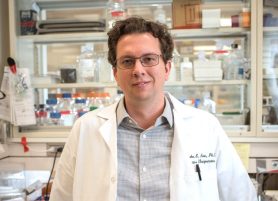- Diseases
- Acoustic Neuroma (14)
- Adrenal Gland Tumor (24)
- Anal Cancer (66)
- Anemia (2)
- Appendix Cancer (16)
- Bile Duct Cancer (26)
- Bladder Cancer (68)
- Brain Metastases (28)
- Brain Tumor (230)
- Breast Cancer (718)
- Breast Implant-Associated Anaplastic Large Cell Lymphoma (2)
- Cancer of Unknown Primary (4)
- Carcinoid Tumor (8)
- Cervical Cancer (154)
- Colon Cancer (164)
- Colorectal Cancer (110)
- Endocrine Tumor (4)
- Esophageal Cancer (42)
- Eye Cancer (36)
- Fallopian Tube Cancer (6)
- Germ Cell Tumor (4)
- Gestational Trophoblastic Disease (2)
- Head and Neck Cancer (6)
- Kidney Cancer (124)
- Leukemia (344)
- Liver Cancer (50)
- Lung Cancer (288)
- Lymphoma (284)
- Mesothelioma (14)
- Metastasis (30)
- Multiple Myeloma (98)
- Myelodysplastic Syndrome (60)
- Myeloproliferative Neoplasm (4)
- Neuroendocrine Tumors (16)
- Oral Cancer (100)
- Ovarian Cancer (170)
- Pancreatic Cancer (164)
- Parathyroid Disease (2)
- Penile Cancer (14)
- Pituitary Tumor (6)
- Prostate Cancer (144)
- Rectal Cancer (58)
- Renal Medullary Carcinoma (6)
- Salivary Gland Cancer (14)
- Sarcoma (236)
- Skin Cancer (296)
- Skull Base Tumors (56)
- Spinal Tumor (12)
- Stomach Cancer (60)
- Testicular Cancer (28)
- Throat Cancer (90)
- Thymoma (6)
- Thyroid Cancer (98)
- Tonsil Cancer (30)
- Uterine Cancer (78)
- Vaginal Cancer (14)
- Vulvar Cancer (18)
- Cancer Topic
- Adolescent and Young Adult Cancer Issues (20)
- Advance Care Planning (10)
- Biostatistics (2)
- Blood Donation (18)
- Bone Health (8)
- COVID-19 (362)
- Cancer Recurrence (120)
- Childhood Cancer Issues (120)
- Clinical Trials (628)
- Complementary Integrative Medicine (24)
- Cytogenetics (2)
- DNA Methylation (4)
- Diagnosis (230)
- Epigenetics (6)
- Fertility (64)
- Follow-up Guidelines (2)
- Health Disparities (14)
- Hereditary Cancer Syndromes (124)
- Immunology (18)
- Li-Fraumeni Syndrome (8)
- Mental Health (118)
- Molecular Diagnostics (8)
- Pain Management (62)
- Palliative Care (8)
- Pathology (10)
- Physical Therapy (18)
- Pregnancy (18)
- Prevention (898)
- Research (392)
- Second Opinion (74)
- Sexuality (16)
- Side Effects (604)
- Sleep Disorders (10)
- Stem Cell Transplantation Cellular Therapy (216)
- Support (404)
- Survivorship (322)
- Symptoms (184)
- Treatment (1776)
Researcher found a way to analyze the DNA of individual cancer cells
2 minute read | Published June 12, 2018
Medically Reviewed | Last reviewed by an MD Anderson Cancer Center medical professional on June 12, 2018
Understanding evolution within cancer cells is a longtime interest for Nicholas Navin, Ph.D., an associate professor of Genetics and Bioinformatics. In other words, how does a single, tiny cell with a few mutations grow uncontrollably into devastating disease?
To answer that question, Navin needed to analyze DNA from individual cancer cells, but that proved easier said than done. Traditional methods weren’t useful because they relied on mixtures of millions of cells.
“I spent most of my graduate studies slicing up tumors into multiple regions and doing genomic profiling,” Navin says. “And no matter how much I sliced up the tumor, I would always deal with a mixed population. So that was very frustrating.”
Analyzing DNA from a single cell
A tumor can contain billions of cells, many of which aren’t cancerous, with diverse genetic profiles. The mixed samples Navin was able to collect did not provide clear answers, so he decided to devise a better technique.
In 2011, as a postdoctoral fellow in Cancer Genetics at Cold Spring Harbor Laboratory in New York, Navin published one of the first methods for analyzing DNA from a single cell. The technique, now widely used, involves meticulously isolating an individual tumor cell, amplifying its genetic material to provide enough sample for analysis, and analyzing the DNA for anomalies.
In just a few days, this can be repeated for thousands and thousands of individual cells, creating a picture of the cell diversity within a tumor and how they interact – known as the tumor architecture. Understanding biology at this level can provide valuable insights into cancer growth and progression, particularly in the disease’s early stages.
“You can trace back all the events that occurred up to that one single cell that started the tumor,” Navin says. “That is very useful for studying things like invasion, metastasis and therapy resistance.”
Moon shots collaborations
Navin is confident this technique will benefit both patients and researchers. Through MD Anderson’s Moon Shots Program™, he is collaborating with clinicians across several cancer types to more rapidly incorporate the use of single-cell analysis, with the goal of improving care.
The ability to work with expert cancer doctors and pathologists together under one roof, along with access to a large volume of patient samples, provides an unparalleled advantage for identifying and developing clinical applications, Navin explains.
Through those collaborations, it has become clear that single-cell analysis is extremely useful for both studying a large number of individual tumor cells, and in cases where very few cells are available for study.
Read more about single-cell analysis and how it can benefit the treatment of blood cancers and prostate cancer in Conquest magazine.

